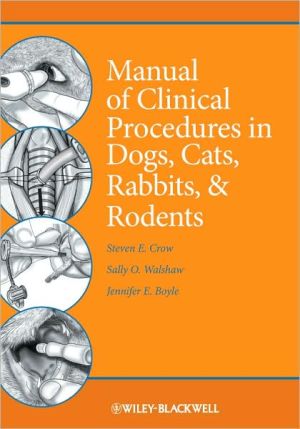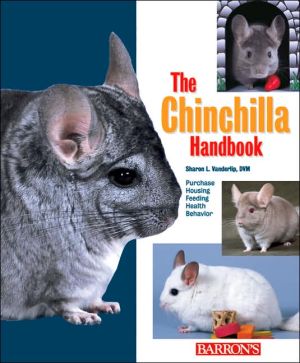Harkness and Wagners Biology and Medicine of Rabbits and Rodents
Harkness and Wagner's Biology and Medicine of Rabbits and Rodents, Fifth Edition is a practical reference in small mammal husbandry and health, encompassing the fields of laboratory animal medicine and pet practice. Part of ACLAM's series of laboratory animal books, this text offers concise but complete coverage on rabbits and the most common rodent species, with an emphasis on biology, clinical procedures, clinical signs, and diseases and conditions. By providing useful, accessible...
Search in google:
Harkness and Wagner's Biology and Medicine of Rabbits and Rodents, Fifth Edition is a practical reference in small mammal husbandry and health, encompassing the fields of laboratory animal medicine and pet practice. Part of ACLAM's series of laboratory animal books, this text offers concise but complete coverage on rabbits and the most common rodent species, with an emphasis on biology, clinical procedures, clinical signs, and diseases and conditions. By providing useful, accessible assessment and diagnostic information, Harkness and Wagner's Biology and Medicine of Rabbits and Rodents aids the practitioner in diagnosing and treating conditions in small mammals. Logically organized for easy reference, the book begins with general husbandry and procedures, followed by specific disease information. Harkness and Wagner's Biology and Medicine of Rabbits and Rodents is essential reading for clinical practitioners, laboratory animal personnel, and veterinary technicians. Key features:Concise but complete coverage of small mammal husbandry and healthEncompasses the fields of laboratory animal medicine, production medicine, and pet practiceLogically organized for easy referenceProvides assessment and diagnostic information to aid in quick diagnosis and treatmentIncludes clinical photographs and case studiesCovers rabbits, guinea pigs, chinchillas, hamsters, gerbils, mice, and rats Randall L. Peper This book provides a good overview of the basic biology and husbandry of rabbits and rodents. It also provides basic information on analgesia/anesthesia, clinical procedures, and common diseases. This is the fourth edition; the previous edition was published in 1989. The goal was to provide concise, up-to-date, reasonably comprehensive information on the husbandry, biology, and medicine of common rodents and rabbits. The authors intended to provide this information in a format that was accessible, useful, and less expensive than the hardcover reference books currently available. The authors intend this book for students, technicians, scientists with a basic knowledge of biology, and veterinarians. They did a reasonable job of not making it too advanced for one group or too basic for the other. The authors are well-known authorities in the field of laboratory animal medicine, with the necessary background and expertise. For the most part, the black-and-white line drawings that are used to illustrate anatomical features and various techniques are sufficiently large and easily understood. The tables provide compilations of much useful information. The references are current, but whether the book contains individual references or simply a section-ending compilation varies from chapter to chapter. The index is extensive and more than adequate. The case reports in Chapter 6 should be of interest to students and teachers. The earlier editions of the book provided one of the best softcover texts on basic biology, husbandry, and medicine of the common rodents and rabbits. This edition is a welcome update and expansion on the previous editions. Although the writing quality and contentvaries from section to section and there appear to be some inconsistencies and discrepancies, the book remains a valuable resource.
Preface xiAcknowledgments xiiiChapter 1 Introduction, General Husbandry, and Disease Prevention 3Introduction 3Sources of Information 5Taxonomy, History, and Behavior 5Regulatory Considerations 6Genetically Modified Mice 7Equipment Needs 9Major Concerns in Husbandry 11Factors Predisposing to Disease 14Allergies to Rabbits and Rodents 17References 19Chapter 2 Biology and Husbandry 23The Rabbit 23The Guinea Pig 45The Chinchilla 58The Hamster 65The Gerbil 74The Mouse 83The Rat 95Chapter 3 Clinical Procedures 107Sample Collection 107Hematology, Clinical Chemistry, and Urinalysis 116Medical Imaging 131Ophthalmology 135Administration of Drugs and Formulary 141Anesthesia 147Analgesia 167Surgery 171Dental Procedures in Rabbits and Rodents 180Serologic Testing for Colony-Health Surveillance 184Other Special Techniques 187Euthanasia 190Chapter 4 Clinical Signs and Differential Diagnoses 195The Rabbit 195The Guinea Pig 208The Chinchilla 219The Hamster 220The Gerbil 228The Mouse 231The Rat 239Chapter 5 Specific Diseases and Conditions 249Acariasis (Mite Infections) 249Anorexia and Reduced Food Intake 260Bordetella bronchiseptica Infections 262Buphthalmia in Rabbits 265Cestodiasis (Tapeworm Infestations) 266Cilia-Associated Respiratory Bacillus Infections 269Coccidiosis (Hepatic) in Rabbits 272Coccidiosis (Intestinal) 275Coronavirus Infections 277Corynebacterium kutscheri Infections 283Cryptosporidiosis 285Dermatophytosis (Ringworm) 287Encephalitozoonosis 289Enteropathies 292Epilepsy in Gerbils 305Gastric Stasis in Rabbits 306Hantavirus Infections 308Heat Prostration 310Helicobacter Infections 311Hematuria and Pigmented Urine 313Hypovitaminosis C (Scurvy) in Guinea Pigs 316Lawsonia Infections (Proliferative Ileitis of Hamsters) 319Listeriosis 321Lymphocytic Choriomeningitis Virus Infection 322Malocclusion and Dental Disease 324Mastitis 327Mousepox (Ectromelia Virus) 327Murine Encephalomyelitis 330Murine Mycoplasmosis 331Murine Norovirus Infections 334Myiasis (Fly Strike)-Primary 335Myiasis (Fly Strike)-Secondary 337Myxomatosis 338Nasal Dermatitis (Sore Nose) in Gerbils 339Neoplasia 341Nephrosis 348Oxyuriasis (Pinworms) 350Parvovirus Infections 353Pasteurella multocida Infections 355Pasteurella pneumotropica Infections 359Pediculosis 361Pneumocystosis 363Pododermatitis 364Pregnancy Toxemia 366Rabies Virus Infection 367Ringtail 368Rotavirus Infections 369Salmonellosis 371Sendai Virus Infections 373Spironucleosis 375Splayleg in Rabbits 377Staphylococcosis 378Streptococcus pneumoniae Infections in Rodents 380Streptococcus zooepidemicus Infections in Guinea Pigs 382Transmissible Colonic Hyperplasia in Mice 383Tularemia 385Tyzzer's Disease 386Ulcerative Dermatitis (Moist Dermatitis) 389Urolithiasis 390Venereal Spirochetosis (Treponematosis) 392Viral Hemorrhagic Disease in Rabbits 394Chapter 6 Case Reports 397The Rabbit 397The Guinea Pig 400The Chinchilla 402The Hamster 403The Gerbil 404The Mouse 405The Rat 406Suggested Solutions 407Rabbits 407Guinea Pigs 412Chinchillas 415Hamsters 416Gerbils 418Mice 419Rats 421Index 423
\ From the Publisher"The stated goal of the book aims to provide an easy to use reference that adds to improving the welfare of rabbit and rodent species. That achievement is reached with this 5th edition; having added over 200 very informative photos, more pertinent case reports, expanded coverage with additional disease descriptions, and wonderful easy-to-read tables. An instant flip of the pages and the reader will connect with this texts ability to inform and teach." (The Vin Book Reviews, 25 February 2011)\ "My overall impression is that this is an indispensable text for practitioners in referral practice or studying towards a higher qualification, but would not be the text of choice for the average general practitioner." (Veterinary Record, 19 March 2011)\ The first edition of Harkness and Wagner's Biology and Medicine of Rabbits and Rodents was published in 1977. Since then, this has become a respected textbook that is commonly found on the bookshelves of people whose profession or hobby involves rodents and rabbits.... Despite the fact that it is now an extensively illustrated reference, this comprehensive text remains an affordable paperback that should be of broad interest." (JAVMA, September 2010)\ "This continues to be a strong introductory text for those caring for rodents and rabbits. The organization of the text facilitates the rapid development of differential diagnoses and performance of general biomethodology when caring for patients." (JAALAS, July 2010)\ "The fifth updated edition of Harkness and Wagner's Biology and Medicine of Rabbits and Rodents is a 'must' for any library strong in small mammal husbandry and health. From lab animal medicine and pet practice to diagnosis, case studies, and clinical assessments of rabbits, guinea pigs, chinchillas, and more, this reference is a key 'must' for practicing clinicians and vet students alike." (The Midwest Book Review, June 2010)\ \ \ \ \ \ Reviewer: Karen L Campbell, DVM, MS, DACVIM, DACVD(University of Illinois College of Veterinary Medicine)\ Description: Published 15 years after the previous edition, this classic book on the biology and diseases of rabbits and rodents contains extensive updates.\ Purpose: The purpose is to provide concise, up-to-date, and relevant information on the health, care, and management of rabbits and rodents. This is excellent resource achieves the authors' objectives. \ Audience: The authors have written this book for a varied audience that includes veterinarians, students, technicians, scientists, breeders, and, to a lesser extent, pet owners. The book will be useful for each of these groups. The authors have outstanding credentials and are noted authorities in the areas of lab animal medicine and care.\ Features: The book is divided into six large chapters, each with subdivisions for the different species of small mammals. It starts with an introduction to laboratory animals and considerations for their use in research. The biology and husbandry of each species is presented next, followed by chapters on clinical procedures, clinical signs and differential diagnoses, specific diseases and conditions, and ending with a series of case reports and references. There are over 200 black-and-white images and many useful tables. I would have liked more information on diagnostic tests in the chapter on differential diagnoses, but this and my preference for color pictures would be my only suggestions for improving the book.\ Assessment: This book is suitable for a much wider audience than books such as the National Research Council's Guide for the Care and Use of Laboratory Animals, 8th edition (The National Academies Press, 2010), although the latter has the advantage of being much less expensive. However, Harkness and Wagner's is much more comprehensive with up-to-date information on newly described diseases and new husbandry guidelines. Therefore, individuals working with rabbits and rodents and desiring a good reference on the biology, health, care, and management of these important species should get the fifth edition.\ \ \ Randall L. PeperThis book provides a good overview of the basic biology and husbandry of rabbits and rodents. It also provides basic information on analgesia/anesthesia, clinical procedures, and common diseases. This is the fourth edition; the previous edition was published in 1989. The goal was to provide concise, up-to-date, reasonably comprehensive information on the husbandry, biology, and medicine of common rodents and rabbits. The authors intended to provide this information in a format that was accessible, useful, and less expensive than the hardcover reference books currently available. The authors intend this book for students, technicians, scientists with a basic knowledge of biology, and veterinarians. They did a reasonable job of not making it too advanced for one group or too basic for the other. The authors are well-known authorities in the field of laboratory animal medicine, with the necessary background and expertise. For the most part, the black-and-white line drawings that are used to illustrate anatomical features and various techniques are sufficiently large and easily understood. The tables provide compilations of much useful information. The references are current, but whether the book contains individual references or simply a section-ending compilation varies from chapter to chapter. The index is extensive and more than adequate. The case reports in Chapter 6 should be of interest to students and teachers. The earlier editions of the book provided one of the best softcover texts on basic biology, husbandry, and medicine of the common rodents and rabbits. This edition is a welcome update and expansion on the previous editions. Although the writing quality and contentvaries from section to section and there appear to be some inconsistencies and discrepancies, the book remains a valuable resource.\ \ \ \ \ BooknewsA classic reference first published in 1977 and most recently in 1989, for veterinarians and people responsible for the health and well being of laboratory animals. Bridges the gap between the expensive and specialized tomes on individual species and the loose pages of lecture notes that laboratory technicians actually refer to. The fourth edition includes new diseases, techniques, and husbandry aspects and replaced some case reports and references with newer ones. Assumes a background in biology. Annotation c. Book News, Inc., Portland, OR (booknews.com)\ \ \ \ \ 3 Stars from Doody\ \








